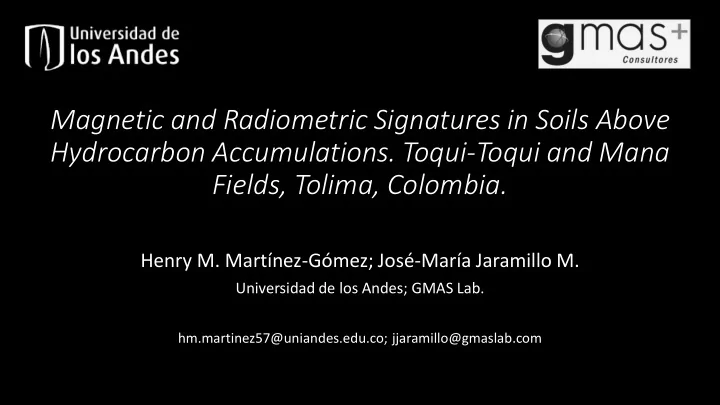

Magnetic and Radiometric Signatures in Soils Above Hydrocarbon Accumulations. Toqui-Toqui and Mana Fields, Tolima, Colombia. Henry M. Martínez-Gómez; José-María Jaramillo M. Universidad de los Andes; GMAS Lab. hm.martinez57@uniandes.edu.co; jjaramillo@gmaslab.com
• Fe 3+ in soils: (Dewangan et al.,2013) • Soluble U 6+ . (Kelly,2010) Low U, high Fe 3+ in soils
GR: 131 POINTS Magnetic Field Strength: 115 POINTS Soil Samples: 82 POINTS
Magnetic Field Strength and GR vs Geology
Analytic Signal
Vertical derivatives of the Magnetic Field Strength
Magnetic Field Strength vs Gamma Radiation
Magnetic Field Strength vs Gamma Radiation (Schumacher, 1996)
Geochemistry
Geochemistry Courtesy of ExxonMobil
X-Ray Diffraction
X-Ray Diffraction
Conclusions The migration of light hydrocarbons (C1-C5) to the surface produces anaerobic conditions that force aerobic bacteria to use dissimilatory metal reduction to conserve energy, thus oxidizing organic or inorganic electron donors and reducing oxidized metals from the soils such as Fe 3+ and U 6+ . This reduction process leads to the precipitation of these elements (Fe and U, among others) into a lower oxidation state, which affects their mobility and forms new minerals in anomalous concentrations (e.g. not related to the local geology) that can be measured with geophysical field instruments. Petroleum exploration begins with the search for hydrocarbon indicators at the surface. With the appropriate geological information and geophysical data, there can be identified mineralogical changes induced in soils by the presence of hydrocarbons and its migration to the surface.
Conclusions Magnetic and Radiometric signatures correlate spatially with Toqui-Toqui and Maná oil fields. The magnetic signature shows a Gaussian effect inside the area of the oil fields due to the precipitation of Fe 2+ on the zone indicated by the vertical derivatives of the Magnetic Field Strength to be the location of the source of the surface anomaly. The radiometric signature shows an aureole effect on the western border of the oil fields due to the precipitation of U 4+ . The precipitation of Fe 2+ and U 4+ is related to diagenetic processes associated to reducing conditions due to hydrocarbons migration to the surface. The difference in their location is due to the mobility of soluble U 6+ , which precipitates as soon as it gets to the border of the reducing zone, thus deflecting on its eastward way to the Magdalena River and leading to the reduction of the mineralized Fe 3+ above the area of Toqui-Toqui and Maná oil fields, which produces the magnetic anomaly correlated to such zone.
Conclusions The Analytic Signal technique is a powerful tool in the exploration of the subsurface that can be combined with near-surface geophysical data for hydrocarbon exploration purposes. Its analysis was combined with information about the petroleum geology of Toqui-toqui and Maná oil fields and regional geology, allowing the identification of important structural features. The chemical composition analysis of the soil samples shows that they have intermediate volcanic parental material, since major elements analysis and REE have the same response as the samples from Nevado Del Ruiz Volcano studied by Jaramillo (1980). However, Gamma-radiating elements and Fe exhibit alteration, which suggests low grade diagenesis.
Conclusions The mineral association of the soil samples studied corresponds to andesitic rocks as parental material, which is typical of the Central Cordillera in northern Andes. This produces masking on the geophysical signatures measured and represents an obstacle on the identification of minerals attributed to diagenetic processes related to the migration of hydrocarbons to the surface. However, evidence of the presence of minerals not related to the parental material nor to the local geology (i.e. stoichiometric Magnetite, Ferroan-Dolomite and Siderite) was found. Their authigenic formation can be predicted from dissimilatory metal reduction associated with the migration of hydrocarbons to the surface on Toqui-Toqui and Maná oil fields.
Conclusions There have not been identified minerals that correlate significantly with GR measurements, so it is proposed the existence of authigenic Uraninite, which is predicted from geophysical and chemical composition analyses, in proportions less than the detection limit of XRD. A significant variability was found in the mineral proportion of the soil samples studied. This is explained by mechanical differentiation during sedimentary processes, which is attributed to different events of alluvial transport of volcanoclastic material from the Central Cordillera and volcanic ash fall. The alteration of the volcanic glass led to the high and variable proportion of clay minerals in the soil samples.
Conclusions The composition of soils as well as the geophysical anomalies do not correspond with the lithology described by SGC (2015) for this area. This is due to the fact that the geological map made by SGC (2015) represents a description of the bedrocks and does not necessarily describe the outcrops, which are the transported parental materials of the soils used for this study. The geophysical anomalies are attributed to the authigenic formation of magnetite and uraninite due to the migration to the surface of light hydrocarbons.
Recommend
More recommend